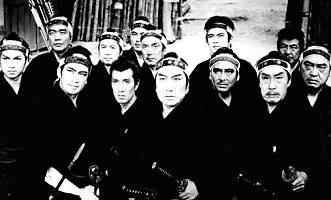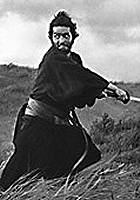|
|
| Sei in: Cinema e Medioevo « Indice alfabetico dei film |
SEPPUKU
1962, regia di Masaki Kobayashi

Scheda: Nazione: Giappone - Produzione: Shochiku Films Ltd. - Distribuzione: Shochiku Films Ltd., Signal International - Soggetto: dal racconto Ibunronin ki di Yasuhiko Takiguchi - Sceneggiatura: Shinobu Hashimoto - Fotografia: Yoshio Miyajima - Montaggio: Hisashi Sagara - Musiche: T˘ru Takemitsu - Formato: B.N. - Durata: 135'.
Cast: Tatsuya Nakadai, Rentaro Mikuni, Shima Iwashita, Akira Ishihama, Shichisaburo Amatsu, Yoshio Aoki, Jo Azumi, Hisashi Igawa, Yoshio Inaba, Akiji Kobayashi, Masao Mishima, Ichir˘ Nakaya, Kei Sato, Ryo Takeuchi, Tetsuro Tamba.



![]() Trama e commenti:
it.wikipedia.org -
film.35mm.it -
film.tv.it -
mymovies.it:
źNel 1630 il r˘nin (samurai errante e disoccupato) Hanshiro Tsugumo chiede a
un potente signore ospitalitÓ per potere fare seppuku (ossia harakiri) secondo
il rituale prescritto. Per dissuaderlo gli si racconta la storia di Motome, un
altro r˘nin, che tempo prima aveva fatto la stessa richiesta ed era stato
obbligato a darsi la morte con un pezzo di bamb¨, invece che con la spada che
non aveva, prima di farsi decapitare come il rito prescrive. Tsugumo rivela che
Motome era suo genero e che si era giÓ vendicato, disonorandoli, dei tre
responsabili della sua morte. MorirÓ anche lui, eroicamente. Film di
prim'ordine: alla magistrale costruzione drammaturgica, incalzante nella sua
solennitÓ, e alla suggestiva tenuta figurativa, con squarci di violenza inaudita
per l'epoca, unisce una forte carica di critica sociale verso il formalismo del
bushido (il codice d'onore dei samurai) e una impressionante descrizione della
miseria del XVII secolo attraverso la quale traspare un discorso sul Giappone
moderno╗.
Trama e commenti:
it.wikipedia.org -
film.35mm.it -
film.tv.it -
mymovies.it:
źNel 1630 il r˘nin (samurai errante e disoccupato) Hanshiro Tsugumo chiede a
un potente signore ospitalitÓ per potere fare seppuku (ossia harakiri) secondo
il rituale prescritto. Per dissuaderlo gli si racconta la storia di Motome, un
altro r˘nin, che tempo prima aveva fatto la stessa richiesta ed era stato
obbligato a darsi la morte con un pezzo di bamb¨, invece che con la spada che
non aveva, prima di farsi decapitare come il rito prescrive. Tsugumo rivela che
Motome era suo genero e che si era giÓ vendicato, disonorandoli, dei tre
responsabili della sua morte. MorirÓ anche lui, eroicamente. Film di
prim'ordine: alla magistrale costruzione drammaturgica, incalzante nella sua
solennitÓ, e alla suggestiva tenuta figurativa, con squarci di violenza inaudita
per l'epoca, unisce una forte carica di critica sociale verso il formalismo del
bushido (il codice d'onore dei samurai) e una impressionante descrizione della
miseria del XVII secolo attraverso la quale traspare un discorso sul Giappone
moderno╗.
![]() Plot Summary, Synopsis, Review:
IMDb -
entertainment.msn.com
-
umich.edu -
filmref.com
-
tvguide.com:
źAfter the
centralization of political power in Japan in the 17th century, the samurai have
been displaced. They wander the countryside asking estate owners' permission to
commit hara-kiri, hoping the wealthy landowners will take pity and give them
work. Nakadai, an aging samurai, wanders into an estate and makes his request.
He is told by the estate's chief retainer, Mikuni, of a young samurai, Ishihama,
who had arrived earlier asking the same thing. To keep the samurai code pure,
Ishihama was forced to commit hara-kiri with a bamboo sword (he had sold his
real sword to provide for his family). Undaunted, Nakadai asks each of the
estate's three principal swordsmen to serve as his second in the ritual. When
the time for the ritual comes and none of the swordsmen show up, Nakadai reveals
himself as the father-in-law of the dead Ishihama. To revenge the dead samurai,
Nakadai cuts off the top knots of the three swordsmen, thus dishonoring them.
Mikuni orders his men to kill Nakadai and in the ensuing battle many are killed
by the old samurai, until he, too, falls. Mikuni then orders his three swordsmen
to commit hara-kiri and declares that the whole incident must be kept secret╗.
Plot Summary, Synopsis, Review:
IMDb -
entertainment.msn.com
-
umich.edu -
filmref.com
-
tvguide.com:
źAfter the
centralization of political power in Japan in the 17th century, the samurai have
been displaced. They wander the countryside asking estate owners' permission to
commit hara-kiri, hoping the wealthy landowners will take pity and give them
work. Nakadai, an aging samurai, wanders into an estate and makes his request.
He is told by the estate's chief retainer, Mikuni, of a young samurai, Ishihama,
who had arrived earlier asking the same thing. To keep the samurai code pure,
Ishihama was forced to commit hara-kiri with a bamboo sword (he had sold his
real sword to provide for his family). Undaunted, Nakadai asks each of the
estate's three principal swordsmen to serve as his second in the ritual. When
the time for the ritual comes and none of the swordsmen show up, Nakadai reveals
himself as the father-in-law of the dead Ishihama. To revenge the dead samurai,
Nakadai cuts off the top knots of the three swordsmen, thus dishonoring them.
Mikuni orders his men to kill Nakadai and in the ensuing battle many are killed
by the old samurai, until he, too, falls. Mikuni then orders his three swordsmen
to commit hara-kiri and declares that the whole incident must be kept secret╗.
![]() Approfondimenti: Movie
Review
Approfondimenti: Movie
Review
Conosciuto anche con il titolo: Harakiri.